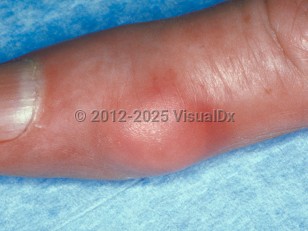Gout - Cellulitis DDx
See also in: Overview,Nail and Distal DigitAlerts and Notices
Important News & Links
Synopsis

The acute form of gout presents as a painful, swollen, warm, and erythematous joint, usually monoarticular. The most common joints affected are the first metatarsophalangeal joints (great toe, also known as podagra or foot gout), ankles, feet, and knees. The pain can be debilitating. Flares can last days to weeks if untreated and can become more severe and more frequent over time.
Chronic tophaceous gout presents most commonly involving the ear but can also affect other soft tissues, articular structures, bursas, and tendons. Smooth or multilobulated nodules can ulcerate, leading to extrusion of a chalk-like substance. Rarely, urate bullae may develop. In uncontrolled chronic gout, there may be frequent acute attacks that lead to destructive arthritis and joint deformity.
Men aged 40-50 years are most commonly affected. Other risk factors include renal insufficiency, obesity, increased alcohol consumption, medications (eg, diuretics), lymphomas, leukemias, tumor lysis syndrome, and hemolysis, as well as lead exposure (eg, from illegally distilled liquor, or "moonshine"; known colloquially as "saturnine gout").
Individuals who are immunocompromised (such as from chronic kidney disease, diabetes mellitus, autoimmune disorders, and malignancies, including leukemia or lymphoma) may have an altered presentation of gout and an increased risk of complications, including infections complicating ulcerated tophaceous gout.
Gout should be distinguished from cellulitis on the basis of involved body location and possible previous history of similar attacks. Gout does not spread like the plaques of cellulitis.
Codes
M10.9 – Gout, unspecified
SNOMEDCT:
90560007 – Gout
Look For
Subscription Required
Diagnostic Pearls
Subscription Required
Differential Diagnosis & Pitfalls

Subscription Required
Best Tests
Subscription Required
Management Pearls
Subscription Required
Therapy
Subscription Required
Drug Reaction Data
Subscription Required
References
Subscription Required
Last Updated:11/24/2024
 Patient Information for Gout - Cellulitis DDx
Patient Information for Gout - Cellulitis DDx- Improve treatment compliance
- Reduce after-hours questions
- Increase patient engagement and satisfaction
- Written in clear, easy-to-understand language. No confusing jargon.
- Available in English and Spanish
- Print out or email directly to your patient


